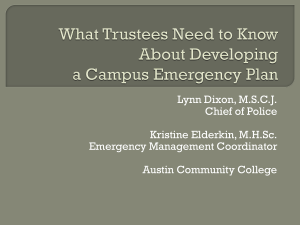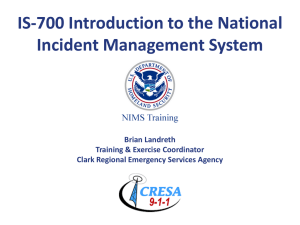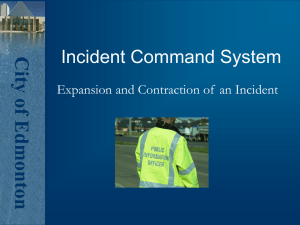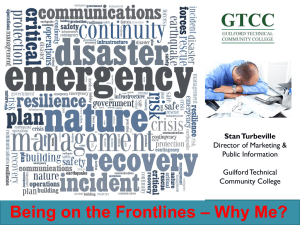Emergency Communication
advertisement
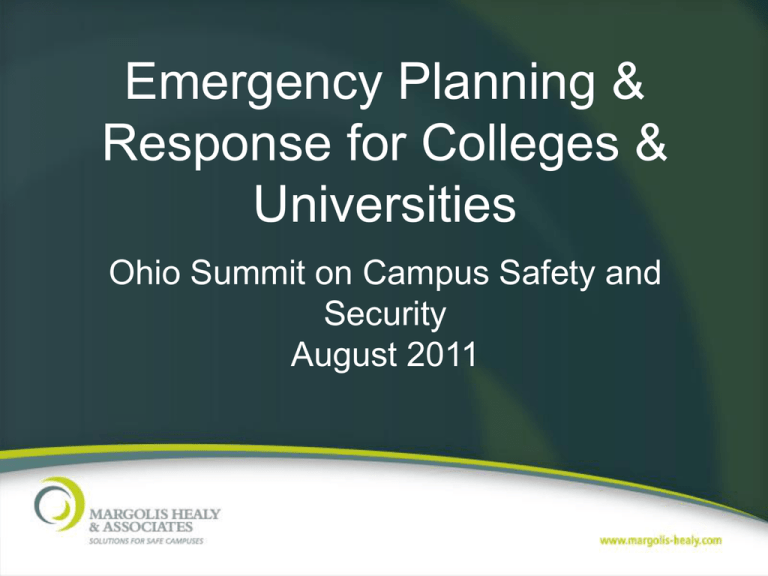
Emergency Planning & Response for Colleges & Universities Ohio Summit on Campus Safety and Security August 2011 Agenda • Critical Incidents Defined • Legal Considerations • Concept of Operations • Emergency Management Planning • NIMS/ICS Overview Critical Incident Defined An extraordinary event which places lives and property in danger and requires the commitment and coordination of numerous resources to bring about a successful resolution Examples of Critical Incidents • Natural Disasters • Transportation Accidents • Information Technology Failures • Criminal Activities • Fire/Hazardous Materials Accidents Goals for the Institution • Contain and Resolve • Restore normal operations and core business and educational functions 4 Phases of a Critical Incident • Crisis (0 – 60 minutes) • Scene Management (hours to days) • Executive Management (a week or longer) • Recovery (days or weeks) Why develop a plan? • Most importantly, to mitigate risk and minimize harm • Fulfill legal duty to exercise reasonable care to prevent foreseeable harm Why the Duty to Prevent Harm? • Well established in tort liability and case law ✓ You own/control premises ✓ You operate programs, on and off campus ✓ Sometimes, you have “special relationships” with students What risks? • Premises-related • Risks due to employee/other negligence • Risks from those who intend to cause harm • Sometimes, risk of students’ harm to themselves AASCU How to fulfill duties? • Plan alternatives: ✓ One approach: script/cookbook ✓ better approach: flexible, allhazards “concept of operations” plan Where to find guidance? • Beyond NRP, there are now some federal and state statutes governing aspects of emergency planning and NIMS/ICS compliance. • Good news: published, best practice summaries (e.g., Blueprint for Safer Campuses) and post-incident reports may be used to establish standards of care. Where to find guidance? • BAD NEWS: if you fail to consider recommendations and findings of summaries and reports, argument could be that this course of actions falls below standard of care. FEMA Guidelines 1.Prevention/Mitigation 2.Preparedness 3.Response 4.Recovery Prevention/Mitigatio n • • • Actions taken to prevent... Actions taken to decrease… Actions taken to reduce... Preparedness • Strategies, processes, and protocols to prepare the institution for critical incidents. • Adopt and institute the Incident Command System (ICS) and assign roles and responsibilities that meet the institution’s culture and capabilities. • Acknowledge role of local first responders and develop Memorandums of Understanding/Agreement to support these understandings. Response • Actions taken to effectively contain, stabilize, and resolve an emergency situation. The institution should expand its ability to respond to allhazards, as the response will be significantly impacted by the severity, magnitude, duration, and intensity of the situation. Recovery • Return to normal operations… • Damage Assessment and Recovery; • Implementation of the COOP; • Emotional and mental health of students, staff, and faculty; • Logistical issues such as receiving donations and volunteers Problems that always arise • Communications • Who’s in charge? • Resources and Resource Coordination • Intelligence gathering and problem assessment • Crowd and traffic control • Environment • Planning and training • Media • Politics HSPD-5 • Created a National Response Plan (NRP) • Under the NRP, a National Incident Management System (NIMS) developed • Ensures consistent nationwide framework for local, state, and federal agencies • Use of the Incident Command System (ICS) Concept of Operations • Provides an “All Hazards” campus wide operational plan • Provides Effective and Efficient Incident Management, from Pre-Planning & Initial Response Through Recovery • Provides Effective Communications - Internal and External • System for Incident Management while Providing Critical Campus Operations Campus Concept of Operations • Executive Policy Group • Emergency Operations Center • Command Post • Initial Response Campus Concept of Operations • Initial Response ✓ Scene Isolation and Stabilization • Command Post Operations ✓ Scene Management & Resolution 7 Critical Tasks for the On-Scene Supervisor 1. Inner Perimeter 2. Outer Perimeter 3. Staging Area (in between perimeters) 4. ID and Request Resources 5. Identify the “Danger Zone” 6. Establish Communications 7. Establish Scene Command Post Campus Concept of Operations • Emergency Operations Center (EOC) ✓ Focus on impact of the incident on the institution ✓ Provides coordination and networking with scene(s) ✓ Major logistics, Maintenance of Routine Operations Proper Mix of Participants in EOC • The LOCATION of the incident determines the divisions, colleges and departments that should be involved • The KIND of incident dictates the functional departments of the involved divisions or colleges, as well as other agencies that may be involved Command Post vs. EOC • Command Post – a central decisionmaking area established by the Incident Commander to house command staff (esp. during Crisis Phase) • Emergency Operations Center – fully expanded ICS for larger management challenges (est. during executive management phase) Campus Concept of Operations • Executive Policy Group (overall guidance) ✓ Focus on impact to the institution ✓ Organize and direct policy decisions ✓ Insulate ✓ Inform/Update VIPs ✓ Politics ✓ Message to the campus & public Challenges with Institutional Response • Confusion and/or delays in response can cause further exposure to danger and increased property damage • Don’t need to be an expert (information will come from experts) • Need a system that will allow you to put experts to work rapidly • Must organize quickly to carry out requests from experts and first responders Checklist for Plan • Administrative Framework ✓ Levels of Emergency Response ✓ Phases of Emergency ✓ Definitions (executive authority; policy group; emergency planning group; roles for each) ✓ Key Roles ✓ EOC Checklist for Plan • Response Framework ✓ Declare & Coordination of Emergency Condition ✓ Emergency Communications Checklist for Plan Emergency Communication • Understanding Emergency Notifications ✓ TAU • How to Notify the Campus Community • Confirmation of Emergency • Content of the Notification ✓ AIR • Exempt Circumstances (Prof. Judgment) Checklist for Plan Emergency Communication Covers a broad array of potential threats – not just Clery Act crimes Applies only to threats occurring “on-campus” Excludes threats occurring off-campus or in public property areas Only exception is if issuing notice compromise efforts to contain the emergency Checklist for Plan Emergency notifications should be issued when it is determined that there is a “significant emergency or dangerous situation involving an immediate threat to the health or safety of students or employees occurring on campus.” Checklist for Plan • An “immediate threat to the health or safety of students or employees” including: ✓ All “hazards” - not just Clery crimes ‣ Terrorist Attack ‣ Natural Disaster ‣ Environmental ‣ Other Checklist for Plan • Confirmation of “Significant Emergency” ✓ Articulates the “process used” to confirm the emergency or dangerous situation that threatens the health or safety of students or employees. • Segment or Segments to Receive ✓ Permits institutions to determine which segment or segments are at risk. ✓ Must disclose the “process” used to determine which segment(s) would receive notification Checklist for Plan • Content -- Explain how the notification content will be developed. ✓ For example, could designate the campus police department or could jointly designate the University police and public relations. ✓ Intention is to discourage a process that will delay issuance. Checklist for Plan • Initiate Notification “Without Delay” ✓ The regulations do not directly define what is meant by immediately notify. ‣ Withheld only if issuing would "compromise efforts to contain the emergency." ‣ Includes "efforts to assist a victim or to contain, respond to, or otherwise mitigate the emergency.” ✓ A list of the titles of the person or persons or organization or organizations responsible for carrying out these actions Checklist for Plan • Need Not Issue Timely Warning ✓ If you issue an emergency notification no need to also issue a timely warning based on the "same circumstances.“ ✓ Adequate Follow-Up Information ✓ Provide adequate follow-up information such as an all-clear or updates about continuing steps taken to respond to an emergency, i.e., class cancellations. Checklist for Plan • Plans & Agreements ✓ All Hazards List ✓ Sample Communications Messages ✓ Mutual Aid Agreements ‣ Other IHEs ‣ Area First Responders Incident Action Plans Written or verbal action plans at the field response level, which reflect the overall strategy and specific tactical action and support information for the next specified operational period. Areas of Emphasis (legal) • Drill EPG on process • Train those who need to know about reporting structures, legal responsibilities, how to care for selves and others • Be sure that threat assessment/studentat-risk teams have shared understanding of privacy vs. safety balance, and applicable laws Benefits of ICS • Uses a common language and response culture; • Optimizes combined efforts; • Eliminates duplicative efforts; • Establishes a single command post; • Allows for collective approval of operations, logistics, planning, and finance activities Benefits of ICS • Encourages a cooperative response environment; • Allows for shared facilities, reducing response costs, maximizing efficiency, and minimizing communication breakdowns; and • Permits responders to develop and implement one consolidated Incident Action Plan (IAP). Next Steps • STEP 1: Get Organized • STEP 2: conduct a safety and vulnerability study • STEP 3: Develop/Update Emergency Ops Plan • STEP 4: Train to the plan Contact Information shealy@margolis-healy.com www.Margolis-Healy.com 866-817-5817


